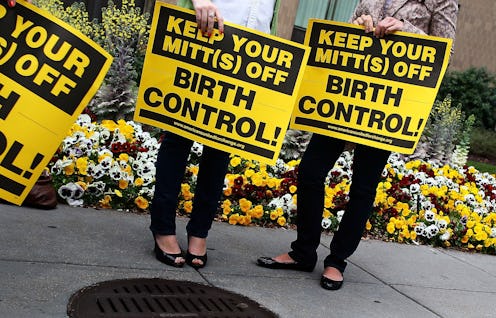The IUD has been gaining momentum in recent years, and with good reason: It’s one of the most effective methods of birth control out there. There are still a lot of misconceptions surrounding the device, though — so in the name of sexual transparency, reproductive rights activist and Abortion Access Fund board member Alison Turkos did something awesome: She live-tweeted her IUD insertion this past Tuesday using the hashtag #TurkosIUD. She subsequently put the whole thing up on Storify, and it should definitely be required reading for anyone remotely invested in reproductive rights and contraception. Just sayin’.
IUDs gained a bad rep during the '70s, when the extremely poorly designed Dalkon Shield caused injury, pelvic inflammatory disease, and in some cases death in hundreds of thousands of women. Although the device was pulled from shelves in 1974, the tarnish it left on the concept of IUDs in general dramatically reduced the number of women willing to use it for decades afterward. When the hormone-releasing Mirena hit the market in 2001, though, opinions about IUDs finally began to turn around. It’s now used by 2 million women in the U.S., while still more use the ParaGuard, the Mirena’s copper-based counterpart.
So why live-tweet getting a little T-shape thing shoved up your cooch? “Because I wanted to reduce the stigma and shrine of secrecy around reproductive and sexual health and the experiences so many people have,” Turkos said to the Huffington Post. “Also, I rely on my feminist/reproductive health community for support in so many ways, why not this too?” Amen to that. I think Turkos’ live-tweeting is important for a couple of reasons. First, it demystifies the whole process; I had no idea what to expect when I got my own Mirena inserted two years ago, and while I wasn’t frightened about the process, it’s still kind of nice to know what you’re going into when you walk into your OB/GYN’s office. Second — and perhaps most importantly — by opening up the conversation, it helps tear down some of the remaining fears about the devices themselves. The Dalkon Shield was just one type of IUD, but because of its history, it came to represent the entire genre of contraceptive to which it belonged. The technology has come a long way since then; moreover, the Dalkon Shield was an outlier in the first place. The Mirena and ParaGuard are both safe and effective, and the more we talk about them, the less maligned the device will be.
Here’s how the whole thing went down via Storify:
As I mentioned in the paragraph above, I opted for a Mirena two years ago; however, my own insertion was a little more…shall we say, epic than they usually tend to be. I say this not to scare anyone off from getting one — on the contrary, having a Mirena inserted was probably one of the best decisions I ever made — but it’s worth noting that, although Turkos’ experience was far more common, the whole thing does vary from person to person, largely depending on the arrangement of your insides.
As my doc and I embarked on our journey toward IUD-ness, we discovered that my vaginal canal zigzags in a way a lot of women’s don’t. This isn’t to say that it’s “abnormal”; I’ve never had any issues because of it and I’m generally perfectly healthy down there. It is, however, a little bit unusual, which made the insertion process kind of creative: What should have been about a 10-minute procedure ended up taking somewhere around an hour and a half, three doctors, and two IUDs (the first one broke when they were trying to maneuver it around all those curves. Apparently my vagina thinks it is a special snowflake. Or something).
But! To be honest, it really wasn’t all that bad. Sure, it feels a little weird when the device is making its way past your cervix (if you haven’t given birth to any other tiny humans yet, it’s probably a sensation you haven’t experienced before); it’s not by any means unbearable, though, even if the insertion takes as long as mine did.
There are myriad other benefits to getting an IUD as well (besides, y’know, the whole effectively preventing pregnancy thing). First off, it was way more cost effective in the long run — I paid out of pocket for mine since I didn’t have insurance at the time; even then, though, comparing the up-front cost of the Mirena itself with the cost of a packet of pills a month over the five to seven years for which the IUD will be operational yielded a much friendlier dollar amount. Note that Obamacare may change the math here these days; check HealthCare.gov for details about what's covered, and go visit Planned Parenthood's website and Tumblr for some additional information. Oh, and as an added bonus, it turns out I’m one of those women for whom the side effects of an IUD include not just lighter periods, but no periods at all. I thought maybe not getting my period each month would freak me out, but you know what? It’s actually kind of amazing. Sometimes I still get hormonal acne and a teeny, tiny bit of incredibly light spotting, but no actual bleeding — which is a welcome change from the years of heavy bleeding and cramping. I love it.
The Hairpin published one of the most comprehensive and accessible guides to IUDs I’ve ever seen back in 2012; it was one of the primary things that convinced me to get one myself, so in case you’re also considering an IUD, I highly suggest reading it. Bustle's Ariana Tobin also put together an IUD FAQ to answer some of your most pressing questions about the device, because the more informed we all are, the better. After all, anything that makes sex even better can only be a good thing, right?
Images: Giphy (3)
SaveSave
